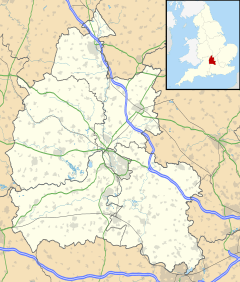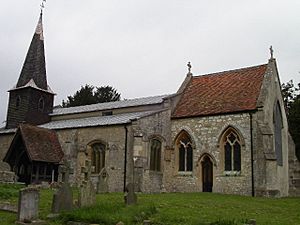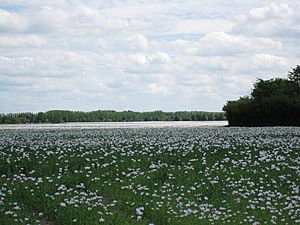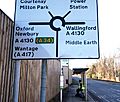Didcot facts for kids
Quick facts for kids Didcot |
|
|---|---|
| Town | |
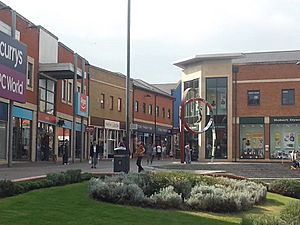 Didcot town centre, including the modern art installation The Swirl |
|
| Area | 8.48 km2 (3.27 sq mi) |
| Population | 26,920 (2011 census) |
| • Density | 3,175/km2 (8,220/sq mi) |
| OS grid reference | SU525900 |
| • London | 54.7m |
| Civil parish |
|
| District | |
| Shire county | |
| Region | |
| Country | England |
| Sovereign state | United Kingdom |
| Post town | Didcot |
| Postcode district | OX11 |
| Dialling code | 01235 |
| Police | Thames Valley |
| Fire | Oxfordshire |
| Ambulance | South Central |
| EU Parliament | South East England |
| UK Parliament |
|
| Website | Didcot Town Council |
Didcot ( DID-kot-,_--kət) is a railway town and civil parish in the ceremonial county of Oxfordshire and the historic county of Berkshire. Didcot is 15 miles (24 km) south of Oxford, 10 miles (16 km) east of Wantage and 15 miles (24 km) north west of Reading. The town is noted for its railway heritage, Didcot station opening as a junction station on the Great Western Main Line in 1844. Today the town is known for the railway museum and power stations, and is the gateway town to the Science Vale: three large science and technology centres in the surrounding villages of Milton (Milton Park), Culham (Culham Science Centre) and Harwell (Harwell Science and Innovation Campus which includes the Rutherford Appleton Laboratory).
Contents
History
Ancient and medieval
The area around present-day Didcot has been inhabited for at least 9000 years, a large scale archaeological dig between 2010–2013 produced finds from the Mesolithic, Neolithic, Iron Age and Bronze Ages. During the Roman era the inhabitants of the area tried to drain the marshland by digging ditches through what is now the Ladygrove area north of the town near Long Wittenham, evidence of which was found during surveying in 1994. A hoard of 126 gold Roman coins dating to around 160 CE was found just outside the village in 1995 by an enthusiast with a metal detector; this is now displayed at the Ashmolean Museum on loan from the British Museum.
In early historical records Didcot was recorded as Dudcote and Doudecothe amongst other similar names, deriving from the personal name Dydda and the Anglosaxon word for house or shelter, cott. The name is believed to be derived from that of Dida, a 7th-century Mercian sub-king who ruled the area around Oxford and was the father of Saint Frithuswith, now the patron saint of both Oxford and Oxford University. Didcot was then a rural Berkshire village and remained that way for centuries, only occasionally appearing in records. At the time of the Domesday Book in 1086 Didcot was much smaller than several surrounding villages, including Harwell and Long Wittenham, which are now dwarfed by modern Didcot. Didcot was not explicitly named in the Domesday Book with the closest recorded settlement being Wibalditone, with 21 inhabitants and a church, the name possibly survives in Willington's Farm on the edge of Didcot's present-day Ladygrove Estate. Parts of the original village still exist in the Lydalls Road area where the Church of England parish church of All Saints is located, the church's nave walls dates from 1160.
Early modern era
In the 1500s Didcot was a small village of landowners, tenants and tradespeople with a population of around 120. The oldest house still standing in Didcot is White Cottage, a Grade II listed wood shingle roofed, timber-framed building on Manor Road which was built in the early 16th Century. At this time the village centre consisted of a collection of small houses and surrounding farms around Manor, Foxhall and Lydalls Roads, those still standing include The Nook, Thorney Down Cottage and Manor Cottage which were all constructed in the early to mid-17th Century. Didcot village was on the route between London and Wantage (present day Wantage Road) and hosted three turnpikes (toll gates). These brought in revenue for local landowners and gentry and operated between 1752 and 1879 when they were abolished due to the growing use of the railway.
19th and 20th centuries: Introduction of the Railway
Great Western Railway

The Great Western Railway, engineered by Isambard Kingdom Brunel, reached Didcot in 1839. In 1844 the Brunel-designed Didcot station was opened. The original station burnt down in the later part of 19th century. Although longer, a cheaper-to-build line to Bristol would have been through Abingdon farther north, but the landowner the first Lord Wantage is reputed to have prevented that alignment. Its presence and that of a junction to Oxford created the conditions for the future growth of Didcot. The station's name entrenched an orthodox spelling of Didcot.
Didcot, Newbury and Southampton Railway
Didcot's junction of the routes to London, Bristol, Oxford and to Southampton via the Didcot, Newbury and Southampton Railway (DN&S) made the town of strategic importance to military logistics, in particular during the First World War campaign on the Western Front and the Second World War preparations for D-Day. The DN&S line has since closed and the sites of the large Army and Royal Air Force ordnance depots that were built to serve these needs have disappeared beneath the power station and Milton Park Business Park, however the 11 Explosive Ordnance Disposal Regiment RLC is still based at the Vauxhall Barracks in the town.
Remains of the Didcot, Newbury and Southampton Railway are still in evidence in the eastern part of town. This line, designed to provide a direct link to the south coast from the Midlands and the North avoiding the convuluted Reading/Basingstoke route, was constructed from 1879–1882 after previous proposals had floundered. It was designed as a main line and was engineered by John Fowler and built by contractors T.H. Falkiner and Sir Thomas Tancred, who together also constructed the Forth Bridge. It was a very expensive line to build due to the heavy engineering challenges of crossing the Berkshire and Hampshire downs with a ruling 1 in 106 gradient to allow for higher mainline speeds, and this over-capitalisation coupled with initial traffic barely meeting expectations caused the company financial problems, meaning it never reached Southampton of its own accord but had to join the main London and South Western Railway line at Shawford, south of Winchester.
However, from the outbreak of World War II such was the growth of wartime traffic to the port of Southampton a decision was made to upgrade the line which included the complete doubling of the northern section between Didcot and Newbury, closing for 5 months in 1942/3 while this was carried out. Several of the bridges in the Didcot/Hagbourne area were also strengthened and rebuilt.
Although passenger trains between Didcot and Newbury were withdrawn in 1962, the line continued to be used by freight trains for a further four years and oil traffic to the north from the refinery at Fawley near Southampton was a regular feature. In 1966 however, this traffic also was withdrawn, and the line was then dismantled. The last passenger train was a re-routed Pines Express in May 1964, diverted due to a derailment at Reading West. A section of the abandoned embankment towards Upton, now designated as a Sustrans route, has views across the town and countryside.
21st century
Didcot is currently home to around 26,000 people. The new town centre, the Orchard Centre, was opened in August 2005. As part of the Science Vale Enterprise Zone, Didcot is surrounded by one of the largest scientific clusters in the United Kingdom. There are a number of major science and technology campuses nearby, including the Culham Science Centre, Harwell Science and Innovation Campus, and Milton Park. The Diamond Light Source synchrotron, based at the Harwell Campus, is the largest UK-funded scientific facility to be built for over thirty years.
Didcot has been designated as one of the three major growth areas in Oxfordshire; the Ladygrove development, to the north and east of the railway line on the former marshland, is set to double the number of dwellings in the town since construction began in the late 1980s. Originally, the Ladygrove development was planned to be complete by 2001, but the plans for the final section to the east of Abingdon Road were only announced in 2006. In anticipation of the completion of the Ladygrove development, a prolonged and contentious planning enquiry decided that a 3,200-dwelling development will now be built to the west of the town, partly overlapping the boundary with the Vale of White Horse.
In 2008 a new £8 million arts and entertainment centre, Cornerstone, opened within the Orchard Centre. It contains exhibition and studio spaces, a cafe and a 236-seat auditorium. Designed by Ellis William Architects, the centre is clad with silvered aluminium panels and features a Window Wall, used to connect the building with passing shoppers.
The United Kingdom government named Didcot a Garden town in 2015, the first existing town to gain this status, providing funding to support sustainable and environmentally-friendly town development over the coming 15 years.
Military
The British Army has a presence within the town at Vauxhall Barracks which is situated on the edge of town. The regimental headquarters of 11 Explosive Ordnance Disposal Regiment RLC is based here.
Sport and leisure
Didcot Town Football Club's home ground is the Draycott Engineering Loop Meadow Stadium on the Ladygrove Estate, having moved from their previous pitch off Station Road in 1999 to make way for the new supermarket development. The club currently play in the 8th tier of the English Football League system. Most notable achievements include winning the FA Vase in 2005 and reaching The FA Cup 1st Round in 2015. Didcot has three main leisure centres: Didcot Leisure Centre, Didcot Wave Leisure Pool and Willowbrook Leisure Centre.
Didcot has its own chapter of the Hash House Harriers. The club started in 1986 (the first run was on 8 April of that year). Didcot Cricket Club's current home ground is at Boundary Park in Great Western Park. Didcot Dragons Korfball club was founded in 2003. The club has two teams in the Oxfordshire leagues. They train in Willowbrook Leisure Centre in the winter and Boundary Park in the summer. Didcot Phoenix cycle club was founded in 1973 and is represented by over 70 members who participate in a range of cycling activities including touring, time trials, road racing, Audax, cyclocross and off-road events.
The Didcot & District Table Tennis Association (DDTTA) was established in 1949 to promote the playing of table tennis in the Didcot area. It organises an annual league competition containing affiliated teams from towns and villages across south Oxfordshire. Didcot Runners is an AAA affiliated running club that meets every Tuesday & Thursday for group runs and fitness sessions at Didcot Town Football Club. Its members participate in running races across the country. The OVO Energy Women's Tour, a road cycling event, passed through Didcot on 12 June 2019. The race was halted for around 30 minutes on the Broadway because of a crash that caused the withdrawal of race leader Marianne Vos.
Parks, gardens and open spaces
Didcot Town Council maintains the following:
- Edmonds Park
- Loyd Recreation Park
- Smallbone Recreation Park
- Garden of Remembrance
- Marsh Recreation Ground
- Great Western Drive Park
- Ladygrove Park and Lakes
- Ladygrove woods
- Ladygrove Skate Park
- Mendip Heights Play Area
- The Diamond Jubilee Garden
- Broadway Gardens
- Stubbings Land
- Millennium wood at the Hagbourne Triangle
- Cemetery, Kynaston Road
Didcot also has a nature reserve, Mowbray Fields, where wildlife including common spotted orchid and Southern Marsh Orchid occur.
In popular culture
Didcot's synonymous connection with railways was noted in Douglas Adams and John Lloyd's humorous book the Meaning of Liff, published in 1983. The book, a "dictionary of things that there aren't any words for yet", referred to "a Didcot" as "The small, oddly-shaped bit of card which a ticket inspector cuts out of a ticket with his clipper for no apparent reason". Didcot is also referenced in Ricky Gervais' comedy feature film: David Brent: Life on the Road, the song "Lady Gypsy" on the film's soundtrack tells of a romantic meeting "by the lakeside, just south of Didcot".
Nearby places
 |
Abingdon | Oxford | Berinsfield |  |
| Wantage, Grove | Wallingford, London | |||
| Newbury | Blewbury | Reading |
Economy
Power stations
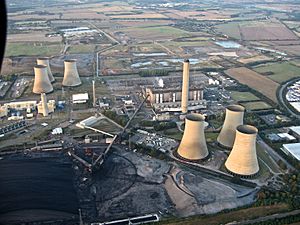
Didcot A Power Station (between Didcot and Sutton Courtenay) which was commissioned in 1968, ceased generating electricity for the National Grid in March 2013. Country Life magazine once voted the power station the third worst eyesore in Britain. The power station cooling towers were visible from up to 30 miles (48 km) away because of their location, but were designed with visual impact in mind (six towers in two separated groups 0.5 miles (800 m) apart rather than a monolithic 3×2 block), much in the style of what is sometimes called Didcot's 'sister' station – Fiddlers Ferry Power Station – at Widnes, Cheshire, constructed slightly earlier. The power station had also proved a popular man-made object for local photographers.
In October 2010, Didcot Sewage Works became the first in the UK to produce biomethane gas supplied to the National Grid, for use in up to 200 homes in Oxfordshire. On Sunday 27 July 2014 three of the six 114-metre (374 ft) cooling towers were demolished in the early hours of the morning, using 180 kilograms (400 lb) of explosives. The demolition was streamed live by webcam. On Tuesday 23 February 2016, part of the boiler house building at the power station collapsed; one person was declared dead, five injured and three missing. All were believed to have been preparing the site for demolition. On Sunday 17 July 2016, what remained of the structure was demolished in a controlled explosion. For safety reasons, robots were used to place the explosive charges, and the site was demolished just after 6am. On Sunday 18 August 2019, the remaining three cooling towers were demolished at 7am.
Car racing

Didcot has a strong connection with the Williams Grand Prix Engineering team as Frank Williams founded the team there in a former carpet warehouse in 1977. After establishing themselves in Formula One, the factory, now including a small 'Williams Museum', moved within Didcot to a new factory on the Didcot A Power Station site on Basil Hill Road. They stayed there until 1995 when they finally outgrew the site, moving to nearby Grove where they are based today. In 2012 a new road through the new Great Western Park development in Didcot was named Sir Frank Williams Avenue in honour of Williams' contribution to the town.
Didcot also hosts a Pirelli distribution and logistics centre which provides tyres for Formula One Grand Prix motor racing events across Europe. Didcot's link to the automotive industry continued in 2015 when the head offices of the Bloodhound SSC team were moved to the new University Technical College (UTC) Oxfordshire site on the boundary between Didcot and Harwell. The team are aiming to break the world land speed record with their supersonic car.
Agriculture
Didcot is surrounded by farmland which has historically grown traditional British crops such as wheat and barley, sheep farming is also common in the area. The area is also noted for farmers growing opium poppies for the pharmaceutical industry. The poppies produced are sold to Macfarlan Smith, a major pharmaceutical company, who hold a licence from the United Kingdom's Home Office.
Printing
From 2007 until 2017, the Daily Mail & General Trust had a printing plant in Didcot.
Education
Didcot is served by seven primary schools: All Saints' C of E, Aureus, Ladygrove Park, Manor, Northbourne C of E, Stephen Freeman and Willowcroft. Along with these seven schools based in Didcot, a further six local village schools form the Didcot Primary Partnership: Blewbury Endowed C of E, Cholsey, Hagbourne, Harwell Community, Long Wittenham C of E and South Moreton County. There is also a new primary, GEMS Didcot Primary Academy, in the Great Western Park area, which falls under Harwell Parish. There are two state secondary schools in Didcot: St Birinus School and Didcot Girls' School are single-sex schools that join at sixth form to host Didcot Sixth Form. Recently, another two secondary schools have opened; UTC Oxfordshire (ages 14–19), in 2015, and Aureus School (ages 11–16), in 2017.
Notable people
- Didcot was the birthplace of William Bradbery, the first person to cultivate watercress commercially in the early 19th century.
- Didcot is the birthplace of former Reading and Oxford United manager Maurice Evans and one of Reading's most-capped football players Jerry Williams.
- Didcot-born rower Ken Lester competed in the 1960 Summer Olympics at the age of 13 in the coxed pairs (as the cox), he remains Britain's youngest ever male Olympian.
- Figurative artist Rodney Gladwell was born in the town in 1928.
- Air Commodore Russell La Forte CBE ADC was born in Didcot in 1960 and was commander of British armed forces in the South Atlantic Islands between 2013 and 2015. He was a member of the Didcot Air Training Corps (Air Cadets) as a child.
- Matt Richardson, a comedian and television presenter known for hosting The Xtra Factor, grew up in Didcot.
- The band Radiohead are from nearby Abingdon and recorded many tracks from their discography in a converted apple shed on the edge of Didcot, near the power station site. This included a number of tracks from OK Computer that has appeared frequently in critic's lists of the greatest albums of all time.
Images for kids
See also
 In Spanish: Didcot para niños
In Spanish: Didcot para niños


